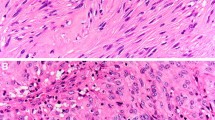Abstract
Vanek´s tumor (inflammatory fibroid polyp) is a rare benign lesion occurring throughout the digestive tract. Histologically, two patterns can be recognized. Classical Vanek´s tumor contains concentric formations of proliferating spindle cells which are CD34 positive. Atypical, inflammatory pseudotumor-like Vanek´s tumor lacks concentric formations and is CD34 negative. Recently, mutations in platelet-derived growth factor receptor alpha (PDGFRA) were reported in gastric and small intestinal Vanek´s tumors. In this study, KIT exons 9, 11, 13, and 17, PDGFRA exons 12, 14, and 18, and a part of exon 15 BRAF for point mutation V600E were screened in 23 cases of Vanek´s tumor, both classical (n = 16) and inflammatory pseudotumor-like (n = 7). No mutations in all analyzed exons of KIT and BRAF and in exon 14 of PDGFRA were detected. Six Vanek´s tumors harbored activating mutations in PDGFRA exons 12 (n = 5) and 18 (n = 1), respectively: S566_E571delinsK (n = 1), S566_E571delinsR (n = 4), and D842 del (n = 1). The mutations were detected in the classical (n = 5), as well as inflammatory pseudotumor-like (n = 1) Vanek´s tumors. The results of this study suggest that the two morphological patterns of Vanek´s tumor more probably represent only variants of one type of tumor than two different lesions. Furthermore, BRAF mutations were not shown to drive growth of PDGFRA wild-type Vanek´s tumors.



Similar content being viewed by others
References
Vanek J (1949) Gastric submucosal granuloma with eosinophilic infiltration. Am J Pathol 25:397–411
Schildhaus HU, Cavlar T, Binot E, Buttner R, Wardelmann E, Merkelbach-Bruse S (2008) Inflammatory fibroid polyps harbour mutations in the platelet-derived growth factor receptor alpha (PDGFRA) gene. J Pathol 216:176–182
Lasota J, Wang ZF, Sobin LH, Miettinen M (2009) Gain-of-function PDGFRA mutations, earlier reported in gastrointestinal stromal tumors, are common in small intestinal inflammatory fibroid polyps. A study of 60 cases. Mod Pathol 22:1049–1056
Daum O, Hes O, Vanecek T et al (2003) Vanek's tumor (inflammatory fibroid polyp). Report of 18 cases and comparison with three cases of original Vanek's series. Ann Diagn Pathol 7:337–347
Agaram NP, Wong GC, Guo T et al (2008) Novel V600E BRAF mutations in imatinib-naive and imatinib-resistant gastrointestinal stromal tumors. Genes Chromosomes Cancer 47:853–859
Agaimy A, Terracciano LM, Dirnhofer S, Tornillo L, Foerster A, Hartmann A, Bihl MP (2009) V600E BRAF mutations are alternative early molecular events in a subset of KIT/PDGFRA wild-type gastrointestinal stromal tumours. J Clin Pathol 62:613–616
Helwig EB, Ranier A (1953) Inflammatory fibroid polyps of the stomach. Surg Gynecol Obstet 96:335–367
Hasegawa T, Yang P, Kagawa N, Hirose T, Sano T (1997) CD34 expression by inflammatory fibroid polyps of the stomach. Mod Pathol 10:451–456
Wille P, Borchard F (1998) Fibroid polyps of intestinal tract are inflammatory-reactive proliferations of CD34-positive perivascular cells. Histopathology 32:498–502
Kim MK, Higgins J, Cho EY, Ko YH, Oh YL (2000) Expression of CD34, bcl-2, and kit in inflammatory fibroid polyps of the gastrointestinal tract. Appl Immunohistochem Mol Morphol 8:147–153
Makhlouf HR, Sobin LH (2002) Inflammatory myofibroblastic tumors (inflammatory pseudotumors) of the gastrointestinal tract: how closely are they related to inflammatory fibroid polyps? Hum Pathol 33:307–315
Zamecnik M (2002) Onionskin-like pattern in inflammatory lesions of the gastrointestinal tract. Hum Pathol 33:1241, author reply 1241-1242
Kim YI, Kim WH (1988) Inflammatory fibroid polyps of gastrointestinal tract. Evolution of histologic patterns. Am J Clin Pathol 89:721–727
Michal M, Vanecek T, Sima R et al (2006) Mixed germ cell sex cord-stromal tumors of the testis and ovary. Morphological, immunohistochemical, and molecular genetic study of seven cases. Virchows Arch 448:612–622
Conflict of interest statement
We declare that we have no conflict of interest.
Author information
Authors and Affiliations
Corresponding author
Rights and permissions
About this article
Cite this article
Daum, O., Hatlova, J., Mandys, V. et al. Comparison of morphological, immunohistochemical, and molecular genetic features of inflammatory fibroid polyps (Vanek´s tumors). Virchows Arch 456, 491–497 (2010). https://doi.org/10.1007/s00428-010-0914-8
Received:
Revised:
Accepted:
Published:
Issue Date:
DOI: https://doi.org/10.1007/s00428-010-0914-8




